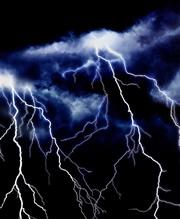 What do lightning and life have in common?Getty
What do lightning and life have in common?GettyThe appearance of life on Earth seems to face so many obstacles — sourcing the right ingredients, for example, and arranging them into living things (while being bombarded by meteorites) — that scientists often feel forced to regard it as almost miraculous. Now two US researchers suggest that, on the contrary, it may have been inevitable.
They argue that life was the necessary consequence of available energy built up by geological processes on the early Earth. Life sprang from this environment, they say, in the same way that lightning relieves the accumulation of electrical charge in thunderclouds.
In other words, say biologist Harold Morowitz of George Mason University in Fairfax, Virginia, and physicist Eric Smith of New Mexico's Santa Fe Institute, the geological environment "forced life into existence".
This view implies not only that life had to emerge on the Earth, but that the same would happen on any similar planet. Smith and Morowitz hope ultimately to predict the first steps in the origin of life based on the laws of physics and chemistry alone.
Inspiring life
Morowitz and Smith admit that they don't yet have the theoretical tools to clinch their arguments, or to show what form this "inevitable life" must take. But, they argue, it probably used the same chemical processes that now drive our own metabolism — but in reverse.
“Life would emerge on any sunny, wet rocky planet.”
Michael Russell, California Institute of Technology.
One source of geological energy would have been compounds called polyphosphates, made in volcanic processes. These are 'battery molecules', similar to those that now supply living cells with energy.
Another source would have been hydrogen molecules, which were probably abundant in the early atmosphere, even though they are almost absent today. Hydrogen would have been generated, for example, by reactions between seawater and dissolved iron.
Energy-releasing reactions between hydrogen and carbon dioxide, belched into the atmosphere by volcanoes, can produce complex organic molecules, the precursors of living systems.
In our metabolism, a series of biochemical reactions called the citric-acid cycle breaks down organic compounds from food into carbon dioxide. Horowitz and Smith say that the energy reservoirs of the young Earth could have driven a citric-acid cycle in reverse, spawning the building blocks of life while relaxing the 'energy pressure' of the environment.
Eventually these processes will have become encapsulated into cells, making the energy flows more efficient. Morowitz and Smith present their ideas in a Santa Fe working paper1.
The right chemistry
The idea is "instructive and inspiring", says Michael Russell, a specialist in the origin of life at the California Institute of Technology in Pasadena. Life, he agrees, is "a chemical system that drains and dissipates chemical energy".
Russell has used similar ideas to argue that "life would emerge using the same pathways on any sunny, wet rocky planet"2,3. The most likely place for it to occur, he believes, is at miniature undersea volcanoes called hydrothermal vents, where the ingredients and conditions are just right for energy-harnessing chemical machinery to develop4.
The biochemical processes of living organisms are highly organized. Scientists have long puzzled over how such systems can come spontaneously into being, when the second law of thermodynamics says that the universe as a whole generates increasing disorder.
ADVERTISEMENT
The answer, broadly speaking, is that local clumps of order come at the expense of increasing the disorder around them. Horowitz and Smith think that such order happens because it is a better 'lightning conductor' for discharging excess energy.
Thus, they say, despite several major extinctions throughout geological time, each of which almost obliterated every living thing, life itself was never in danger of disappearing — because an Earth with life is always more stable than one without. The researchers call this process a "collapse to life", which in their view is as inevitable as the appearance of snowflakes in cold, moist air.
Visit our lifeonearthinevitable.html">newsblog to read and post comments about this story.
-
References
- Morowitz H.& Smith E., Santa Fe Institute Working Paper, (2006).
- Russell M. J., Hall A. J.& Hiscox J. A., . The Search for Life on Mars (British Interplanetary Society), . 26 - 36 (1999).
- Russell M. J., et al. Ikan, R. (ed.) Natural and Laboratory-Simulated Thermal Geochemical Processes, 325 - 388 (2003).
- Martin W.& Russell M. J., . Phil. Trans. Roy. Soc. B, online publication doi:10.1098/rstb.2006.1881 (2006).
